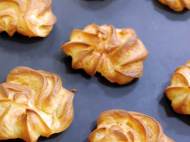Self-cleaning equipment in food industry enables food without preservatives
 Sitting in a cozy sidewalk cafe, watching passersby and enjoying a chocolate-cream éclair – for many of us, this is a portrait of a relaxation, but the bakers who make the éclairs out of pastry dough inside our favorite home made bakery have to use a special machine that they operate by hand. Researchers have developed a system that helps bakers by cleaning itself automatically after every batch of dough.
Sitting in a cozy sidewalk cafe, watching passersby and enjoying a chocolate-cream éclair – for many of us, this is a portrait of a relaxation, but the bakers who make the éclairs out of pastry dough inside our favorite home made bakery have to use a special machine that they operate by hand. Researchers have developed a system that helps bakers by cleaning itself automatically after every batch of dough.
Once made, the dough must be processed at once – otherwise microorganisms will work to ensure that it does not rise when baked. The baker also has to disassemble the machine and clean it thoroughly before it is ready for the next batch of pastry dough. As part of ProEclair, an EU-funded project, researchers at the Fraunhofer Institute for Interfacial Engineering and Biotechnology (IGB), have developed a dough machine that removes the need to disassemble the system after every batch of dough since it automatically cleans itself.
“The dough we make with the machine is also sterile, so it remains fresh comparatively long. We can pack the dough in bags for delivery to the individual bakeries”, said Alexander Karos, IGB group manager. “To make sure the system really is clean after the cleaning procedure is complete, the last rinse water is automatically tested for proteins, fats, carbohydrates and residues of cleaning agent.”
This means the dough is sterile – and for the first time, it can be made in large quantities off-site for delivery to bakeries. The researchers have already developed a prototype of the machine and commissioned it in an industry partner‘s operation.
PreserveWine, another EU project that IGB researchers develop, goes a step further. Aside being able to clean itself, the machinery is also preserving the wine produced. Heating couldn’t be the solution since it would destroy valuable ingredients and destroy the taste of wine.
“With the alternating-pressure technology we have developed, we can ensure that the wine has a long storage life – without the use of preservatives”, said Karos. “We subject the wine or other liquid food product to a pressure of 300 bar – or 300 times ordinary atmospheric pressure – while adding inert gases at the same time. As a result of the high pressure, these gases diffuse into the cells of the microorganisms in the liquid. If we then drop the pressure back down, the cells burst – the microorganisms have been killed. And the inert gas escapes.”
Researchers will showcase these and other combinations of cleaning methods and equipment at the parts2clean trade fair, October 25-27, 2011, in Stuttgart, Germany. Scientists from a total of six Fraunhofer Institutes will be on hand at the joint Fraunhofer stand to present their latest developments. These include the gentle redirection of dry-ice blasting pellets, improved coating adhesion through material pretreatment in a vacuum, and laser beam-based cleaning.









Great advancement in the preservation of foods.
Dr.A.Jagadeesh Nellore(AP),India